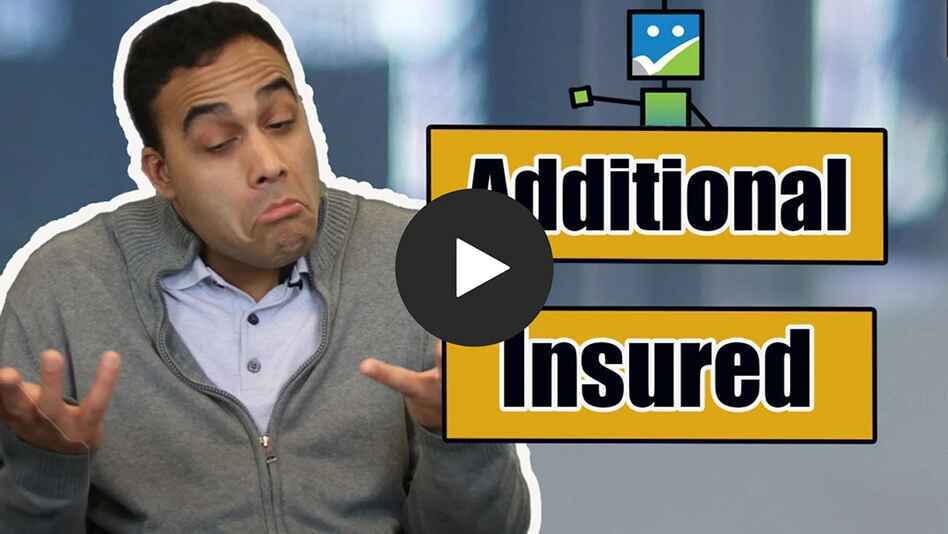
The Basics of Additional Insured Endorsements
While additional insured (AI) endorsements are common in third-party contracting, their logistics can be a bit complicated.
As they extend liability coverage to parties not otherwise insured by the policy, there are several benefits and risks involved with adding an additional insured.
This guide reviews the most common questions and information about AIs to help you make an informed decision about whether to list them on your policies.
What Is an Additional Insured Endorsement?
Endorsements are insurance policy addendums that broaden or restrict coverage.
Specifically, additional insured endorsements extend coverage to a party identified by the policyholder in the event of a claim or negligent acts.
These entities usually have some degree of liability due to their relationship with the named insured. However, while an AI has many of the same responsibilities as the policyholder, they do not pay premiums, receive notices of cancellation, or negotiate terms.
For example: On a subcontractor's commercial general liability (CGL) policy, they are the named insured and can designate a general contractor they are working for as an AI (along with any other required entities). This enables the general contractor to look to the subcontractor’s insurance policy if they are named in a work-related suit.
Are There Different Types of Additional Insured Endorsements?
AI status is often requested on a variety of insurance lines such as professional liability and commercial automobile insurance.
However, it is most commonly requested for CGL insurance.
Why Are Additional Insured Endorsements Important?
Claiming additional insured status provides several benefits and protections for organizations, some of which include:
- Responsibility: It places financial responsibility for a claim on the party most likely to cause it.
- Loss History: It helps protect loss history. If a loss occurs that’s the responsibility of the vendor, the AI can avoid asserting the claim under their policy—keeping loss history low.
- Risk Mitigation: It holds appropriate entities responsible for potential risks.
What Does an Additional Insured Cost & How Is it Added?
Given that it’s the named insured’s responsibility to add AIs, those looking to be listed should note it in their contract.
To add an AI to a CGL policy, the named insured should contact their insurer and provide the party’s name and address.
The cost to list an AI varies depending on the insurance company but can be as low as $50. Some insurers even permit policyholders to pay a flat rate and add as many as they would like.
Beyond the initial costs, adding the endorsement will also affect the policyholder’s premiums. To understand the total costs naming an AI will have on premiums, contact your insurer.
Important Considerations for AI Endorsements
There are three major factors to consider when listing an AI.
1. Submitting the Correct Endorsement Form
Begin by understanding whether the party will be covered for ongoing operations, completed operations, or both.
This will determine which form is appropriate (CG 20 10, CG 20 37, and so on) and inform whether you should accept or reject an insurer’s proprietary endorsement.
Submitting the incorrect form could result in a lapse in coverage.
For example: Let’s say “Vendor A” is doing work for “Company B,” and “Company B” has been named an additional insured for “Vendor A” through the CG 20 10 (ongoing operations only) form. If a claim arises after the project has been completed, the insurer would not cover the claim, as that endorsement does not include coverage for completed operations.
2. Understanding Endorsement Language
Carefully review your endorsement’s language to ensure it accurately reflects coverage and contractual requirements.
If language is incorrect or ambiguous, it will affect the scope of coverage for the AI if an incident occurs.
Look for common details such as:
- Exclusion of coverage for claims not resulting from the named insured’s negligence
- Limitations to the extent a named insured can be held responsible in a claim
3. Avoiding Common Pitfalls
If the named insured or the general contractor is required to extend CGL coverage to a third party, such as a hotel owner or lender, the CGL policy can be amended with an endorsement naming the third party as an additional insured.
Not all AI endorsements are created equally, however, and you should beware of certain language often employed in drafting these tricky insurance provisions.
Here are potential ways that additional insured status could fail to protect you from liability:
- If the endorsement restricts coverage to ongoing operations, then an AI is vulnerable to liability in cases of bodily injury or property damage that occur after the contracted work is complete.
- Sole negligence exclusions eliminate coverage for the AI if found solely responsible for the negligence that resulted in the claim.
- Some states have anti-indemnity laws that prohibit contracts requiring one party to assume liability for negligence committed solely by another or that obligates one party to purchase insurance covering another party's sole negligence. Therefore, it is not uncommon for AI endorsements to contain a provision stating that the coverage applies only to the extent provided by law, meaning in accordance with local anti-indemnity statutes.
- You may encounter a clause in an AI endorsement that states the additional insured will receive coverage that is no broader than the contract. In other words, if the contract states that the AI must be protected against bodily injury or property damage claims but includes a "no broader than the contract" provision, then they may still be held responsible for different types of claims, such as personal and advertising injury.
Can an Additional Insured File a Claim?
Yes, additional insureds can file a claim if they are sued after an incident. However, the results of the claim often depend on the specifics of the endorsement.
To ensure appropriate parties are held responsible, verify all involved understand what’s covered by a policy. Any misunderstandings about coverage can result in AIs incorrectly being held responsible for all or part of the claim.
What Are Blanket Additional Insured Endorsements?
Blanket additional insured endorsements extend a named insured’s coverage to multiple third parties without having to specifically name or request such a status for each.
This is especially important for business operations that require hiring third-party contractors, vendors, or other organizations. These entities seek to limit their liabilities as much as possible and create a clear order of responsibility in the event of a claim. Making this policy addition requires formal submissions from contractors or vendors, which is fairly straightforward and manageable when conducted for one or a handful of entities.
It’s common for businesses to work with hundreds of other companies at any given time, therefore you can imagine that when they all request to be included as an additional insured, the process can become overwhelming and create regrettable mistakes. For example, missing documents or incorrect information can prevent a company from obtaining additional insured status, potentially leaving it open to costly liabilities.
Requesting AI status—from a contractor, for example—is a common way of adding another layer of protection. Should an incident result from contractor negligence, the additional insured language confirms the responsible party will respond to the claim.
Blanket endorsements help businesses reduce the likelihood of making such mistakes by including policy language that extends additional insured status to any entity with which they have a contractual agreement to perform a job—bypassing many traditional steps.
The broad, time-saving nature of blanket endorsements makes the policy a convenient choice for vendors, contractors, and subcontractors. Such policies provide peace of mind and instill confidence.
There are some limitations that all parties should be aware of:
- Ambiguous Language: Standard language around blanket AI endorsements have not historically been given the opportunity to be tested in court, resulting in a lack of clarity surrounding certain aspects of these endorsements. Without legal precedent, it's critical all parties carefully review the endorsement before agreeing.
- Completed Operations: In addition to ambiguities, commonly used language for blanket endorsements lacks coverage for completed operations—a significant gap for many types of projects.
- Notices of Cancellation: Securing notices of cancellation is an important step for companies to take to limit risk. Doing so easily, however, requires inclusion as an additional insured under the policy in question. This is more difficult with blanket endorsements since they do not require the named insured to list additional insureds.
- Contracts Required: The specifics of a blanket endorsement will depend on the stipulations of each policy, but most require a signed contract between the two parties. As such, companies should always make sure to keep such documentation, as it may be required to confirm additional insured status in the event of a claim.
Additional Insured Endorsements Should Not Replace Policies
While these endorsements are an important aspect of third-party partnerships, they should not replace insurance coverage.
AIs can have several coverage limitations and restrictions that are not always obvious until a claim is filed.
Business owners should have insurance policies to cover liabilities that may not be included as an AI.
Simplifying Your Insurance Tracking Process With bcs
While tracking additional insured status, active policies, and other COI necessities can be an involved process, the right solution makes it a seamless one.
Unlike other insurance tracking companies, bcs offers both self-service and full-service compliance solutions. The self-service option gives clients access to best-in-class software, while the full-service solution adds outstanding support for expert compliance analysts.
When you sign on with bcs's full-service option, you're getting more than just advanced analytics software. You're also gaining a dedicated support team of trained auditors who will work closely with you and your team to develop a strategy to suit your unique business needs.
Whether you’re looking to do your own tracking or outsource to a full-service provider, bcs’ fully integrated solution encompasses all aspects of third-party management—from automated requests for proposals (RFP) to vetted hiring and onboarding.
By centralizing all your vendor processes, you can streamline COI tracking, mitigate risks, and form safer business partnerships.
bcs is a leading COI tracking solution with full- and self-service options to help you easily hire, onboard, and manage vendors with a few clicks. To simplify your insurance tracking process with bcs, contact us today or schedule a demo.
Subscribe Now
Learn from the pros about risk-mitigation, document tracking, and more, with expert articles from bcs.






Leave a comment